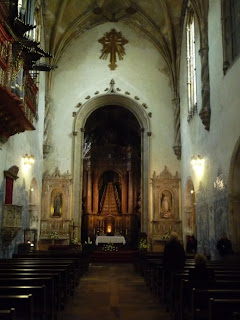 |
Cathedral of Batalha, really flaming gothic
|
 |
West facade, with the "founders' chapel" to the right;
founders being earliest kings, queens, etc., of Portugal
|
 |
At the east end, the unfinished chapel...no roof,
but otherwise pretty overwhelming
|
 |
Nave view...purity, great size and height
|
 |
Dome of the founders' chapel
|
 |
Tomb of first king and queen,
14th century, Joao I and his wife,
Philippa of Lancaster (Portugal and
England have been pals for a long
time; they had a common rival)
|
 |
On the right, her Tudor coat of arms (really ties things
together...)
|
 |
Tomb of their son, Prince Henry, the Navigator,
generally credited with kicking off the Age of Discovery
|
 |
Beautiful stained glass, more Moorish-
looking than Christan, we thought (well,
excluding the coats of arms)
|
 |
Looking into the incredible unfinished chapel,
at the other end
|
 |
Another king and queen, holding hands, in the unfinished
chapel
|
 |
Finished ceiling in one of the side-chapels
of the unfinished chapel
|
 |
Interesting figures around the floor of the unfinished chapel
(scores of these); reminded us of some of the secular
Norman figures we saw near Hereford
|
 |
In the market adjacent; we're going to get
one of these yard sprinklers as soon as we
have a yard again
|
We proceeded on, hoping to catch a few of the small town sights before getting to Lisbon. First was the most impressive cathedral--well, big church--at Batalha. It is really high gothic, 14th century and later, contains some precious tombs, and much more.












































